
Wondering how to market an app?
Don’t worry there are only 2.47 million apps on the Google Playstore, second only to the Apple App store that offers 1.8 million apps to choose from. So yes, as far as competition goes, you have your work cut out.
App marketing, unlike traditional unidirectional advertising, needs to be approached as a full-fledged Tele-show whose touchpoints with consumers need to be multi-dimensional. In fact, the majority of app marketing agencies today are laying additional emphasis on being multi-dimensional and offer promising prospects to clients.
So we took to the task of preparing a checklist of to-dos you should consider, and include in your mobile app marketing strategy.
But before we move on to our mobile app marketing checklist, let’s take a look at the basics, for instance, the definition of mobile app marketing.
What Exactly is Mobile App Marketing?
First thing first, mobile marketing and mobile app marketing are two very different approaches. For instance, mobile marketing can be described as a marketing or promotion activity that takes place on a mobile device. This also includes everything i.e. from mobile-only email marketing to display ads on web pages.
On the other hand, the term mobile app marketing can be defined as promotional marketing campaigns whose primary objective is to communicate with the targeted user base throughout the lifecycle of the service or product that is being promoted through the campaigns. This life cycle consists of various stages that appropriately capture the journey of a regular user converting into a strong advocate for your brand.
What Do You Mean By Mobile App Marketing Funnel?
Now that we have shed light on the definition of mobile app marketing, it's time we move on to the topic of the mobile app marketing funnel. Speaking of the mobile app marketing funnel, it can be categorized as a model or an illustration to guide the audience through the different stages of the entire marketing process i.e. straight from generating brand awareness about the brand to generating significant retention.
To break it down for you, we’ve further simplified the checklist by dividing it as per the life-cycle of an app i.e.,
- Pre-Launch Mobile App Marketing
- Post-Launch Mobile App Marketing
- Retention Stage Mobile App Marketing
You’ll find several pointers to execute as part of your app marketing plan that requires next-to-nothing investment. On the other hand, there are some alternatives where the more money you put in, the better results they yield. In the end, we hope you find the answer to that gnawing question in your heart “how to market your app?”.
Pre-Launch Mobile App Marketing
Foundational and hence crucial, falter here and your first impressions are ruined. Pre-launch app initiatives are something that entrepreneurs can begin with singlehandedly. Yet, if you needed a signpost for the starters, then begin with the simplest thing you could do, research. As mentioned earlier, we’ll list the free to-dos first and the ones requiring money in the bank later.
Pre-Launch Mobile App Marketing - Free Initiatives
1. Set Your Mark
When you are scratching your heads to find out how to launch an app, begin by profiling the user. Creating your buyer persona is tantamount to laying the foundational block of a building. Create an archetype of your consumer. This will help you in aligning the development objectives for your engineers.
Heading - Create Buyer Persona
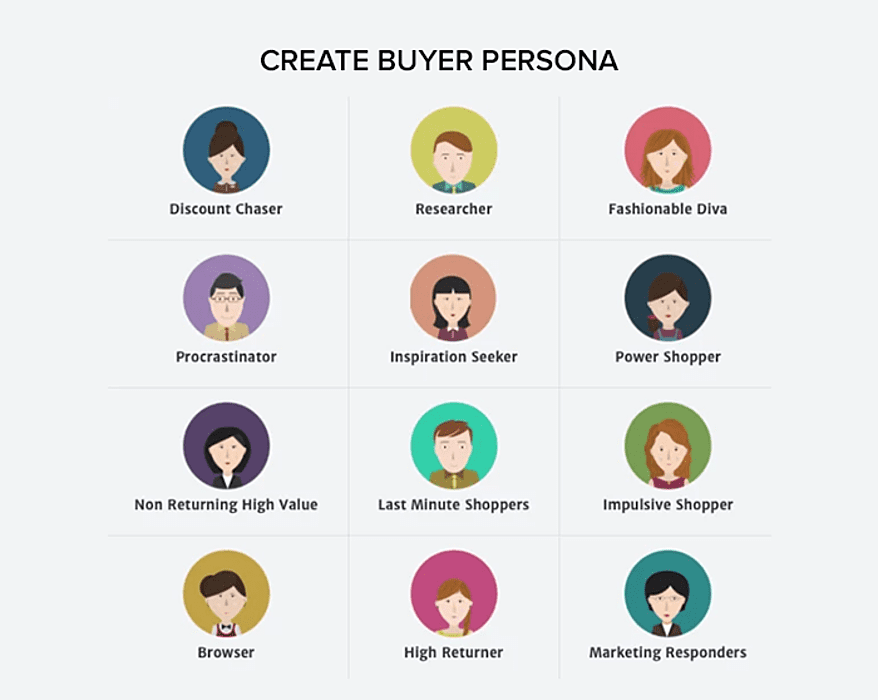
What does your target audience crave, their likes, dislikes, and purchase decisions? Is there a niche operating system that attracts such a demographic. Try to decipher a pattern in visual branding that best attracts your target audience. If you can chisel out the identity of your consumer down to their preferred operating system, iOS or Android, then you’ve hit bulls-eye.
2. Keep Friends Close, Competitors Closer
Knowing your competitors just as well is equally important. It lends differentiation to your product and enhances the value add that would ultimately turn out to be your universal selling point. Identify in the current iteration of your app what is it that you are doing better, the scope of improvement and further opportunities to innovate and overpower competitive forces with your app marketing strategy.
3. Break the News
Your family, friends, relatives should receive advanced heads up about your gig. This is not to brag but to rather gauge their first impressions. Of course, we don’t suggest you to divulge if there is an objection or two. But you’ve got to start somewhere, as part of your journey to figure out how to market an app before launch.
4. (Better) Stick to Deadlines
It’s in the teams’ best interest to set a deadline and (better) stick to it. The move should trickle down into monthly, weekly, daily tasks that ought to be accomplished within the defined time-frame. If you want to make it more challenging for everyone on board, then make the release date of the app public. This should prove a good teaser to soaking up the pressure even as you prepare, test, and validate app marketing strategies.
5. Begin Social Promotion
Creating a business profile on social media doesn’t cost a dime. Neither does share a few well-designed posts on the upcoming launch of your app. Pick the groups that closely associated with your target audience and seek to join them as part of your mobile application marketing plan.
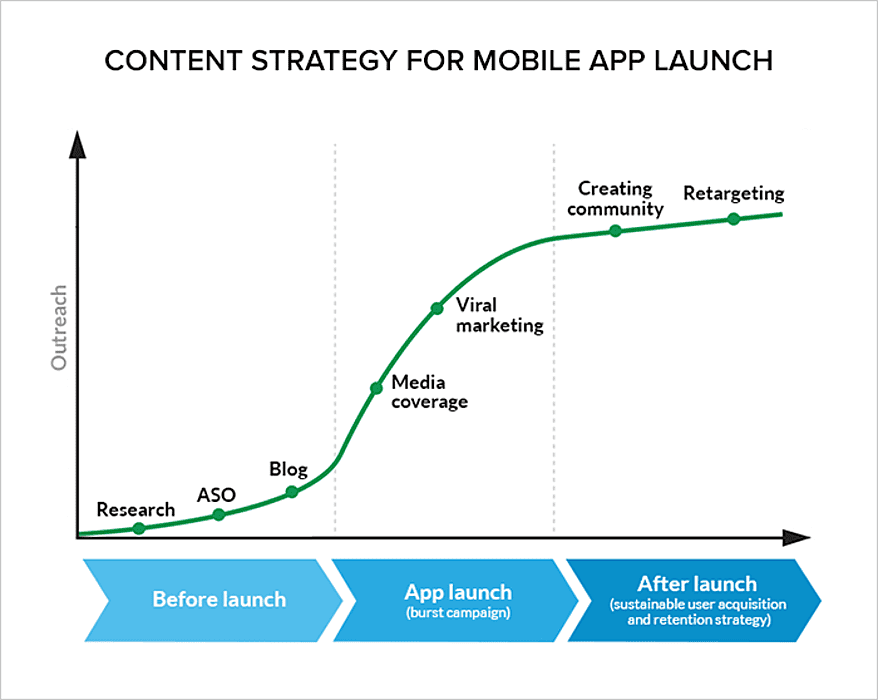
Remember, not to spam them with an overflow of information or you risk being blocked. Likewise, your own business page should have a backdrop of posts that narrate your story and compels the audience to subscribe. The content must be engaging and creative.
6. Snooping on Competitors
Deep dive into every nook and corner of the app store you wish to monetize and scrape through all those apps which are even remotely connected to your revenue model. Keep a track of your list. If it is a long one, then you’re better off sitting on the outskirts and pursue a different idea.
If your final tally is a mild estimate, then probably your best chance lies with app differentiation.

Convert data into tables (like the one above), pie charts, bar graphs, etc and run a comparative assessment evaluating your future success. This methodology would outdo any preconceived notions about the price points, design style guides, and the public response. Who knows, your target audience might be restricted to either iOS or Android only. Such considerations are imperative to a mobile app marketing strategy.
7. Content Marketing Strategy
You’ll oscillate between defining best SEO practices and App Store Optimization (ASO) techniques subject to choosing a befitting mixture of the two for your app. There are app marketing insight tools that extrapolate search keywords volumes, trending/relevant topics in your niche, as well as the practices being employed by your competitors. Here, mobile app marketers also need to be aware of the concept of app store optimization and how ASO can be properly utilized for giving a boost to the app’s ranking.
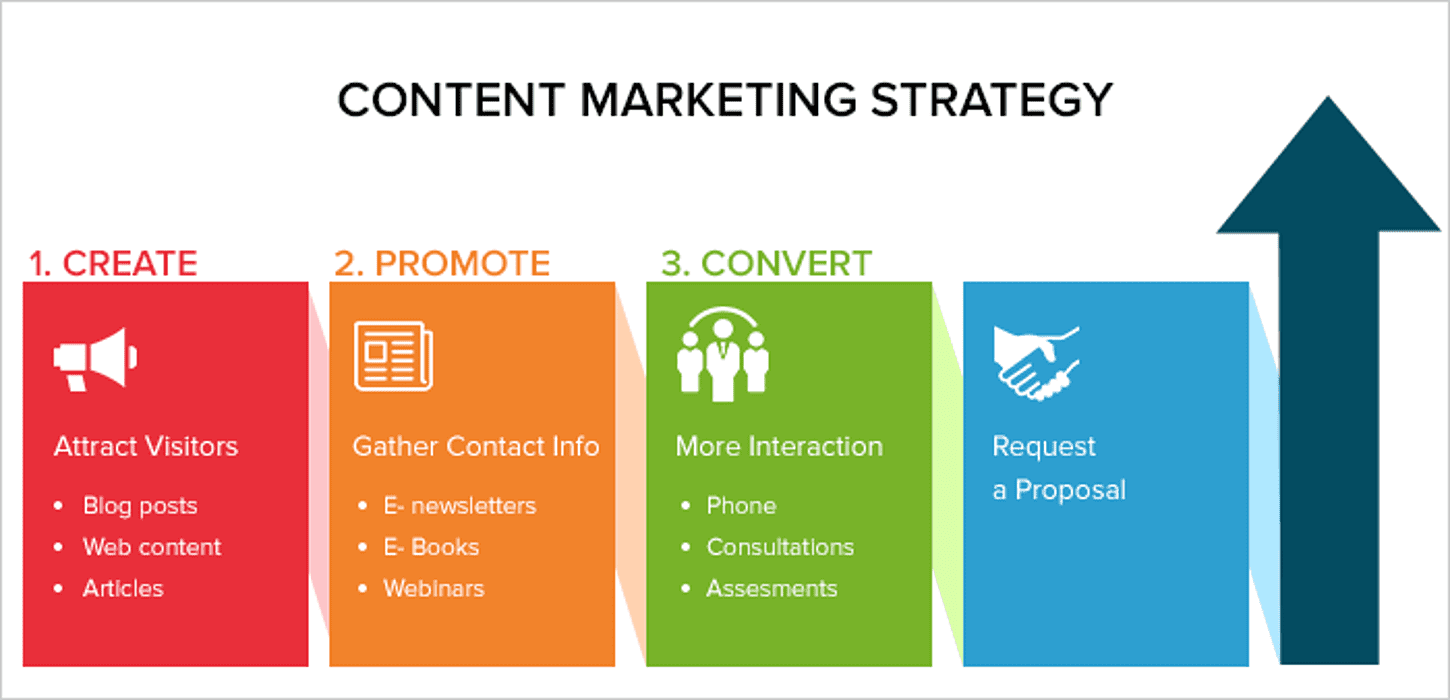
Time allocation at this step cannot be overestimated.
8. Contend with “Content”
By now you should’ve demarcated and prioritized between various online hubs and sub-hubs, to target and strengthen your user engagement metrics, but you’re still missing the last piece of the puzzle. Content. You need a wide variety of collaterals to match different facets of consumer interests such as podcasts, influencers videos, gamification, promotions, freebies, and more. Please note, production comes later whereas refining and finalizing the components of it should be confined to this step.
9. Email Marketing
Choose an Email Service Provider that is renowned for its bulk email processing. Their plug-ins should allow you to track response rates to the point of the most read sections in your template. Prepare a database i.e., if you’ve procured customer credentials from a prior venture.
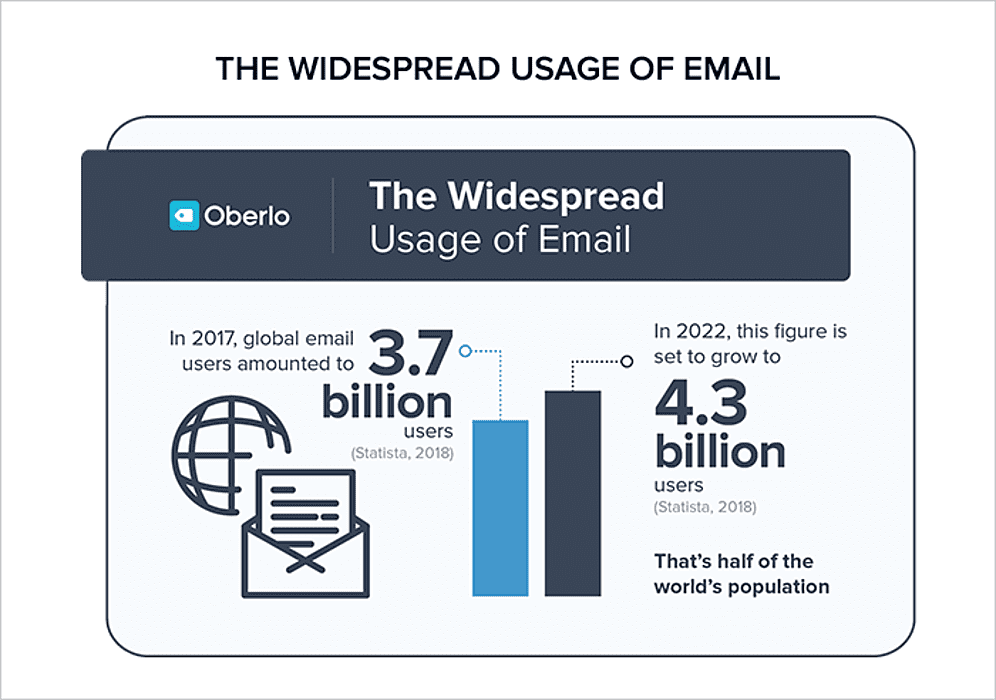
Source: Oberlo
Even if you don’t, there are third-party vendors who legitly sell email records. Yet, how many of those emails are convertible, is something that could be debated. There is also the issue of bulk emails which often automatically end up being junk.
10. Preparing Press Releases
A press release should be succinct and to the point. It should convey the purpose of the headlining news intricately to the readership. Language elements are uncompromisable and should focus on narrating the story behind the headline. It should include quotes from the
hierarchy of the company plus the solution offering people should look forward to.
11. Invite User for Beta Testing
It is a smart decision to keep beta testing as an invite-only group. In fact, do so with your closest family circle or friends who’ll happily take out time to rate the inefficiencies of your product.
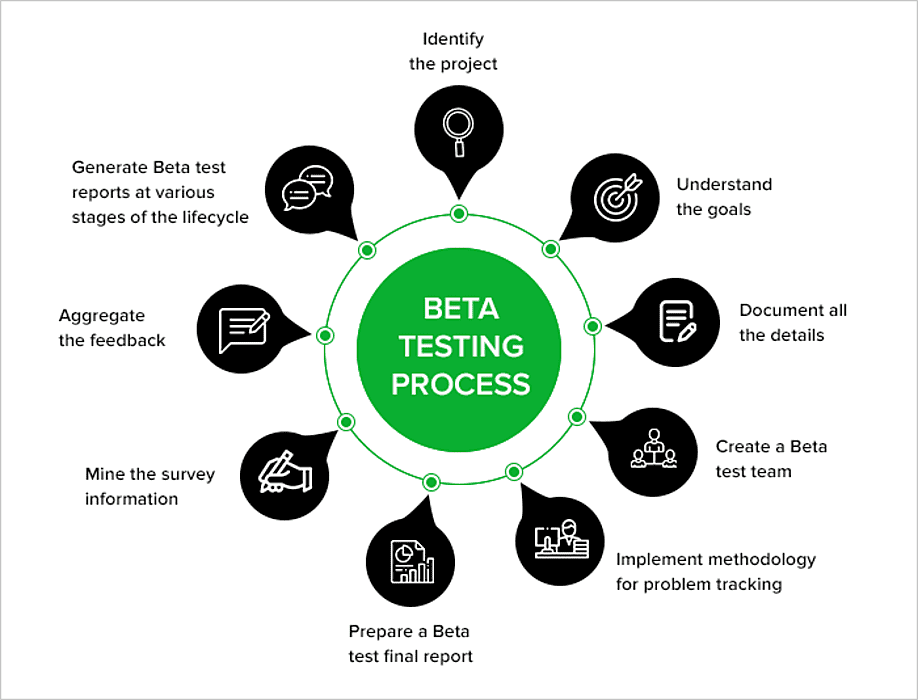
Beta testing often proves a precursor of things to come, giving developers the opportunity to upgrade loopholes, should they diagnose any.
12. Play with Pre-orders
Brand positioning is paramount to unlock massive sales. You have already profiled your users, now it's time tingle their senses with your product. Coupled with the right type of media buying, if you can get downloads in the early hours of the app launch then its game on. One brand that does it superlatively well, is Apple.
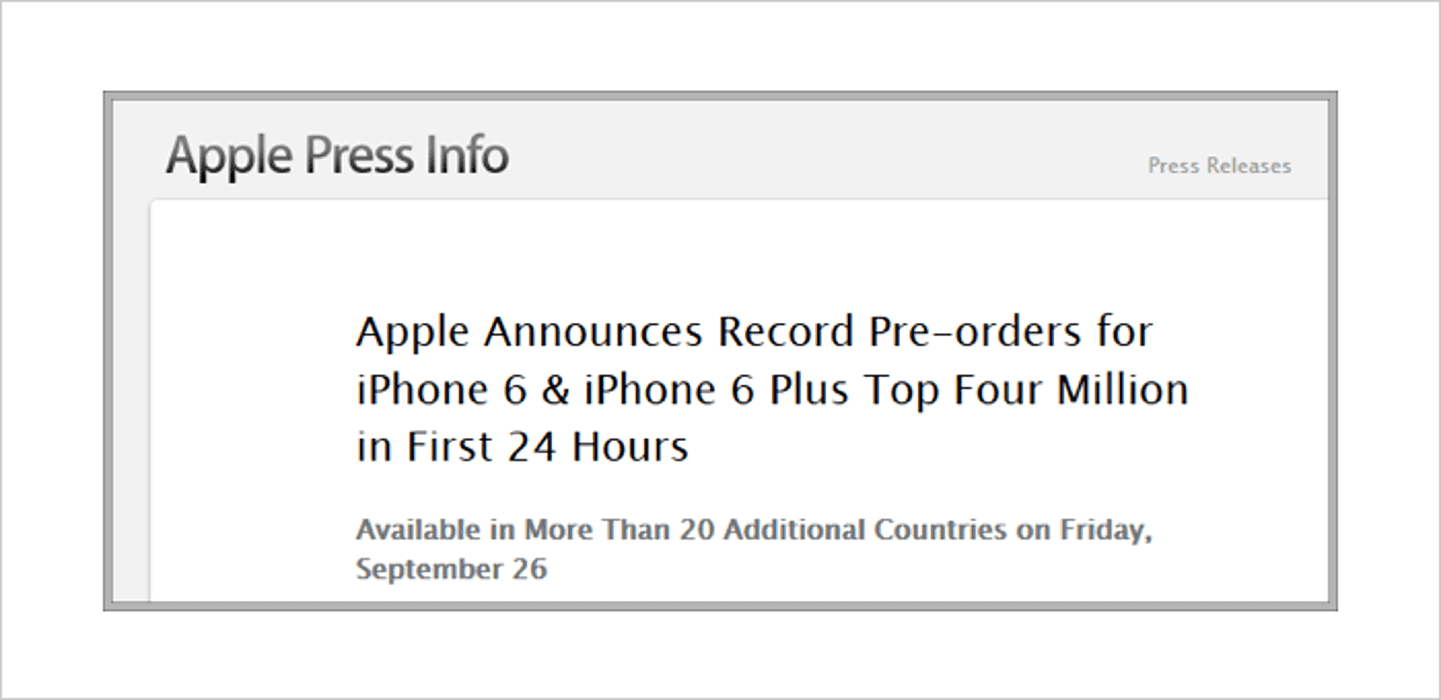
Take the above news, for instance. Apple’s pre-order numbers are so enticing that one reconsiders whether they are missing out on premium quality by not buying in, unlike everyone else. You need to replicate something of this nature, considering it is arguably the last check-boxes you could tick in the free columns. We’ve finally arrived at action points that require monetary support but value for their ask price.
Pre-Launch App Marketing - Paid Initiatives
Here are some of the top paid initiatives that marketers can opt for when it comes to pre-launch mobile app marketing:
1. The All-Star Launch
The gloves are off. Go full-throttle with a frenzied app launch event. Invite all the major media houses to cover the story. Ever since Steve Jobs’ keynote in 2007, CEOs choose to be the face of their organization. As Apple CEO, Tim Cook plays that part really well.
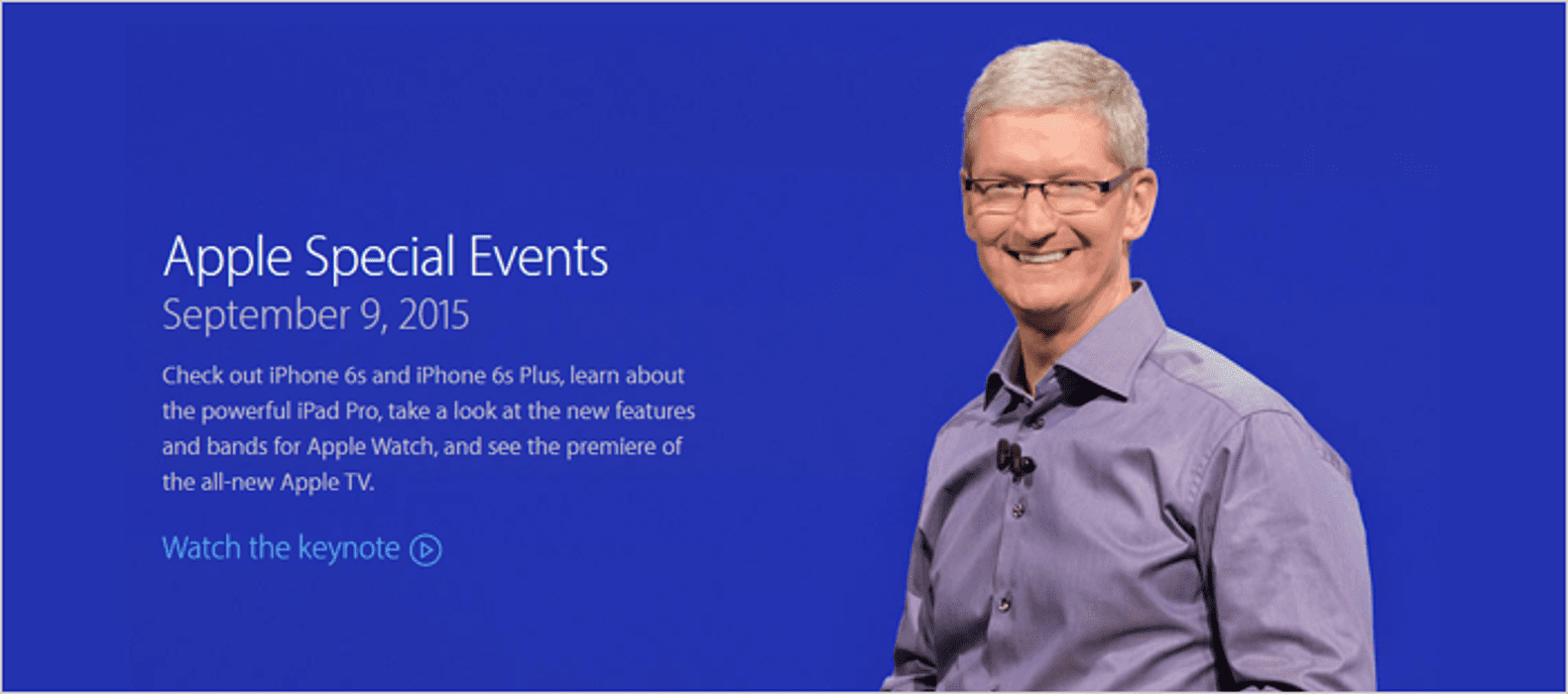
The belief is widespread, that the founding team is best placed to take the audience through its story than hiring an anchor. Whatever you do, the scale of the event should be enough to percolate down to the masses.
2. Build Content around Search Queries
It is all a trickle-down effect. The moment people find out about your app, search engine queries would spike in a hockey stick curve. The more prepared you are in advance targeting the relevant search terms, the more traffic you can cash on. This is when the website and app store optimization you had stitched together comes into autopilot mode directing users from homepage/landing pages to your app store account. Lest we forget, while content optimization is paramount, so is a website design and interface. If your theme is not well-illustrated or leaves questions unanswered, netizens probably would assume that the app would be alike and may not bother to download.
3. Bragging Videos
The best way to market an app is probably with a video. Be it the shift in time or the tsunami of video promotions that viewers have resorted to being the new normal, they have something about them which sticks. As per Google, 6 out of 10 people would rather watch online videos, than television if given a choice.

Youtube is a goldmine when it comes to promoting video ads with 1.8 billion+ monthly users. Marketing on the platform is akin to SEO in that you target the right keywords, location, and time and then let the algorithms do their bit. Your explainer video should be crisp, with the right CTAs provoking the consumer to ‘click’ the follow-up link. It would be worthwhile to consider posting an app review on Youtube once operations are in full swing.
4. Don’t forget the Freeloaders
Their growing adoption is an indication of not just how popular they are but how effective they can be. With iterations such as “Scratch & Win”, “Refer & Earn” or “Share & Win”, you have endless possibilities to define a plausible model that goes viral. Contest pose an obvious answer in response to the question “how to market an app successfully?”.
5. Seek Professional Help
Public relations firms foresee the scope of a product intertwined with their network connections, that could take it from “the what…??” to “Wow..!!!”. Managing the distribution of information onto the public is their job which is why you should consider hiring an expert who can position your app at the mantlepiece that it deserves to be at.
Post Launch Mobile App Marketing
Running an app-business is not a sprint, but a marathon. Consider the activities till now a warm-up. It’s subsequent to your launch that the marketing ought to be streamlined. We begin by doing something old school, mend your brand image.
Post-Launch App Marketing - Free Initiatives
1. Encourage Positive Reviews
Consumers need constant reminding to rate their customer experience on the app store because they are either forgetful or more often than not ignorant. So when you’ve stashed an app with functionalities you’re sure are second to none, then urge users to share their experiences with others. Developers often deploy this trick where they first ask an objective question, “Are you satisfied with the app?”.

If you click Yes, only then are you directed to the app store, or else the interface presents an emoji-based rating card with additional questions inquiring about your issue in detail which brings us to our next point.
2. Give Love To Your Critics
Reputation management is enveloping an entire set of services that include performing a balancing act online. Be it Google reviews or the play store, you should allocate human resources that proactively respond to negative reviews online. A continuous follow-up on individual complaints first, calms the customer who thinks they’ve been hard done by, and second establish you as a customer-centric brand in the market.
It is 80% cheaper to retain a customer than it is to acquire a new one. Observers who see you reach out to miffed customers wouldn’t mind downloading your app, knowing fully you have their concerns covered. Come to think of it, the strategy is counterintuitive and plays out as a smart and strategic way to boost app downloads.
3. Get Your App Reviewed
App reviews add credibility against a brands’ name. In fact, they act as a second-person narrative listing their takeaways from the app and is a key metric for user-generated content. Readers tend to connect with such influencers, especially if they have a standing history doing the same. It is like listening to a film critics give their verdict on the movie and whether to purchase tickets or not! It is not uncommon to find developers submit their own app reviews to specialty/niche websites.
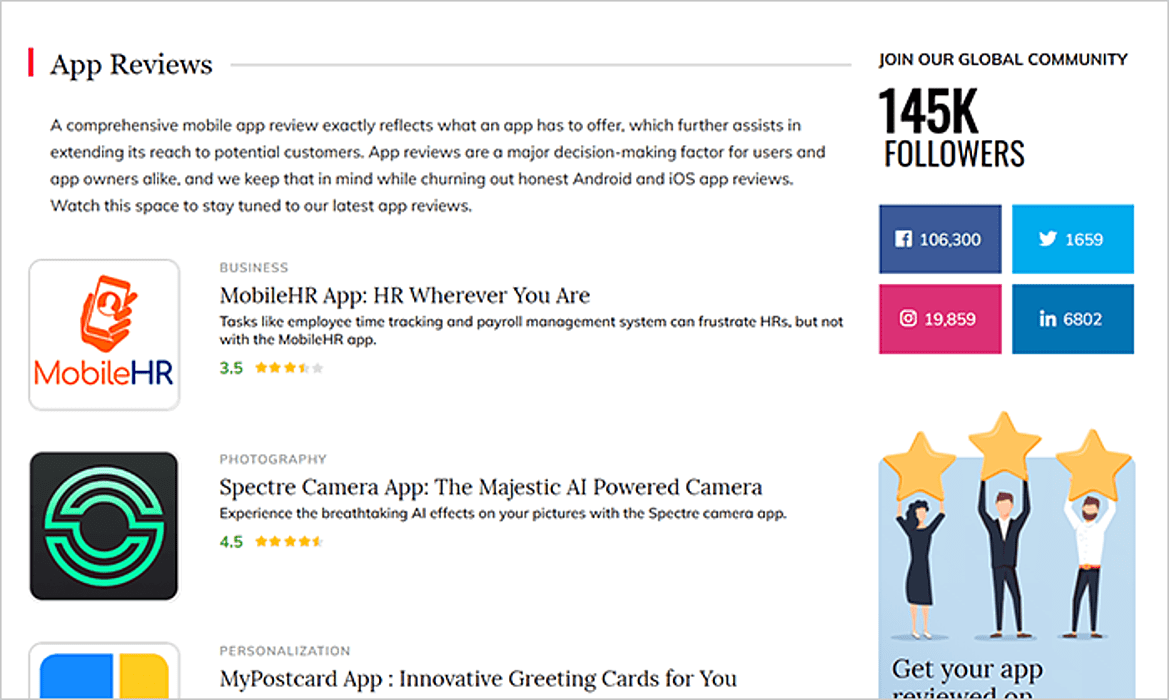
Such web portals offer multifold readership advantages as they direct traffic from relevant interlinks on the same website, to a particular app review, penetrating a mass market that wouldn’t otherwise have heard of the app. Your mobile app marketing efforts would bear tangible results with (in)credible mobile app reviews.
4. Apply for Awards
App install campaigns hit higher dimensions when you’ve bagged the industry’s recognition. The longer the trail of awards you have, the higher the possibility of increasing your market share. Apply for as many awards as possible. The following is a list of recognitions capable of bestowing overnight stardom:
- Appy Awards -Hosted by MediaPost, they reward the chart-toppers of the Apple App Store and Google Play Store.
- Best App Ever Awards - Powered by 148apps.com, they celebrate apps with their flagship categories Best Android Apps, and Best iOS Apps
- Apple Design Awards - As far as mobile app promotion is concerned, it can’t get any bigger than this. Though restricted to the iOS, it is anything far superior to everything out there. Even a nomination would cast the app in a spotlight that outperforms competitors by a mile.
- Appster's Awards - Their event convenes for two days in which no less than 5000 app makers make to the pilgrimage.
- The Webby Awards - They are a hotshot among hotshots when it comes to excellence in any sphere connected to the internet. Webby Awards are usually what distinguishes the best from the rest.
- Best Mobile App Awards - They take place in association with national-level media houses the likes of which include NBC, CNET, ABC, and Yahoo.
5. Push Messages
Pay close attention to push notifications. The average time span of a customer is around 8 seconds. That aspect alone ranks push notifications high up the pecking order in after-launch activities. They are timed quick-bits reminding customers of service level ongoings in the app. Estimates fluctuate anywhere between 56% to 180% in user retention from push notifications.
Moreover, subscribers who accord to notifications display an 88% higher app engagement rate than those who don’t. Notwithstanding the mathematics, they should be high on your list of outreach goals.
Post-Launch App Marketing - Paid
1. Running Ads
Put on the after-burners and go full throttle on paid advertising to lift your mobile app marketing. Monetize every channel available to you. Purchase ad-space in relevant apps to promote yourself through In-app ads.
Spend money on social ads and search engine ads. You can create a multi-network advertising portfolio by directly buying ad space through an ad exchange. Over time, you’ll begin optimizing investment basis audience engagement rates.
2. Leverage Product Hunt
Product hunt is literally a hatchery for tech-startups with an inkling of innovation back-support. After being authenticated by their licensing team, you are free to launch a campaign by depositing a nominal charge.
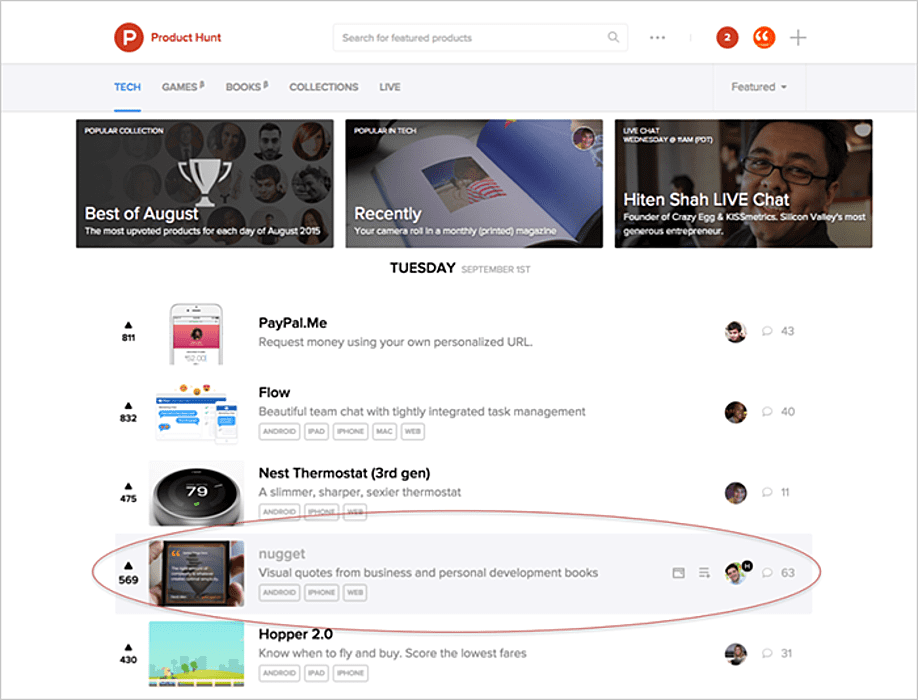
The same is utilized to get your product featured on their campaign page where users could get a feel for the product. They allow beta-phase releases as well, so that’s another silver lining for the fee they charge. Be that as it may, product hunt is mobile app marketing safe haven for appreneurs.
3. Hire Influencers
An affiliate/influencer could be any entity who would recommend you to their audience, online followers, charging you for the conversions. While top bloggers with high organic rankings become your low hanging fruits, it really boils down to the terms of the agreement. The higher they are, the greater the dent they cause in your pocket. However, once you have hold of enough new users, it’s really up to your user retention strategies to grow the operations. Affiliates come in all shapes and sizes, with some strictly blogging, while others maintaining everything from V-logs (video logs) on Youtube, websites, and Instagram accounts. So invest, but prudently.
Retention Stage Mobile App Marketing
Here are some of the top free initiatives that marketers can opt for when it comes to retention stage mobile app marketing:
Retention Stage - Free Initiatives
1. Analyzing Campaigns
Numbers cannot reveal insights unless you learn to decipher their underlying meaning. For the same reason no matter the objective of the campaign, add the lessons learned to your mobile app marketing playbook and try not to repeat the same mistakes costing the business a cash burn. Sync your campaigns to broadcast uniform messages.
In most cases, the marketing tools you use to run ad campaigns, retargeting efforts, or even ASO should invoice enough evidence to either substantiate or dissociate from your present approach. Hence, a cost-benefit analysis is the way forward.
2. Focus on the First-Timers
Research shows that an average app has a churn rate of 77% for first time users within 3-days of usage. Contributing to this could be factors ranging from misplaced buttons on the interface, tiresome signup and verification checks, or over-promising to users leading to unrealistic expectations from the app. Such blockages to a market mass appeal are mendable by app developers and so should be attended to preemptively. A mobile app strategy will only go so far without a robust mobile backend.
3. Renewing App Content
Just like the site content, an app requires a periodic on-load of fresh, consumable content for users. You could succeed at everything else in this guide, but failing this one execution could put the entire mobile app marketing in a downward spiral. Think on your toes, and just like with codes, debug hardwired and uninteresting content pieces to keep users coming back to your app time and again.
4. Tapping Social Media
Replenishing your app with new content isn’t enough. What is your end game to reach customers who haven’t subscribed to push notifications? That is where social media lights up your deals or any other offers that might interest consumers.
The business of apps is a see-saw where you transfer the traffic from social platforms on to the application, and win over hearts through in-app functionalities to then share experiences online. Smartly position share-buttons on the UI to enable interoperability between mobile and web apps. Bridging the gap between the app and social channels is what mobile app marketing will be about, in the mobile app marketing trends that are forming in the foreseeable future.
5. Update the App Regularly
The more you update and resolve in-app code issues, the better its chances of wider acceptance.
Even if the app itself is error-free, which it cannot be, you might want to introduce features to keep pace with competitors. Be sure to take the news to users through notifications, push messages, alerts, or even social posts, so they continue to enjoy a seamless in-app experience. Track the changes that are well received by the public and the ones getting a pushover.
Users are very vocal, and if the latter turns out to be the case, get to damage control mode with your reasons for appeasement (going back to the above point of dispute resolution).
Retention Stage Mobile App Marketing - Paid Initiatives
1. Offer Rewards
Discount Coupons, loyalty points, and referral bonuses are key metrics around which user retention and acquisition now revolve. The governing principle is straightforward and well accounted for, once the users find out how easy it is to earn and redeem points on future purchases they’ll be hooked to the app.
Unlike retail outlets that wait for seasonal savings, apps could enroll people into making daily/weekly/monthly savings. There really doesn’t have to be a reason for giveaways, from making a big purchase order to getting a new user to sign up, it could be anything as far it has a positive mobile app marketing impact.
2. Festive Discounts
Commercial apps are a black hole that sucks the last juices out of consumer pockets, especially when festivities are round the corner. As horrible and tragic as that sounds it is a business norm. Even if in the incipient stages of the business, you are unable to offer daily coupon codes, you should look forward to augmenting sales using festivities with over the top savings. Missing out on this is a big no-no.
From Halloween to Black Friday and Thanksgiving, alter the look and feel of your app with specialized discounts. In case you have a robust big data repository, customize the offers you send to each as per their purchase patterns. Take your mobile app marketing goals to the next level with such festive discounts.
3. Encourage Referrals
Mobile app marketing could be self-sustaining provided you could convince the users to work for you. Word of mouth is traditionally an organic tool fast garbing an inorganic robe, as companies push users to refer and earn specialty points. You work the same way as HR does to recruit new customers only that it is much easier for you to reach out with the click of a share button. But you can manage to score high on net promoter ratings provided everything is fine and dandy on the operations/service front.
Final Thoughts
Gone are the days when marketing used to be “smart”. Today it’s an open conundrum best solved by those who know how to extract the best of both worlds i.e., free and paid. Likewise, you need to keep tabs on the latest trends affecting your industry vertical in particular. While there are no guarantees in life you can be assured of this, if you miss out on any of these postulates, your competitors sure won’t. Yet, if you hang on to this checklist, you’re outreach matrices would pose a handsome picture than otherwise.
Frequently Asked Questions
-
Why app marketing is crucial?
As per a stat, your app is only successful if you are in the top 0.1% of the viewable app store. Due a combination of factors affecting app ranking, it is necessary you have an omnichannel promotional plan for your app.
-
How do you launch a successful app?
-
How do I advertise my new mobile app?
-
How Do I market my application?










